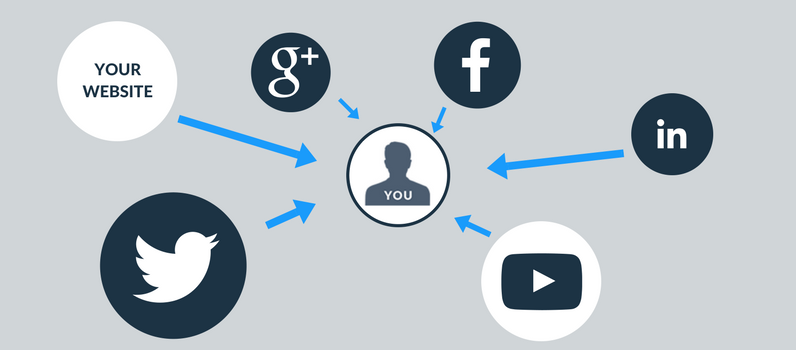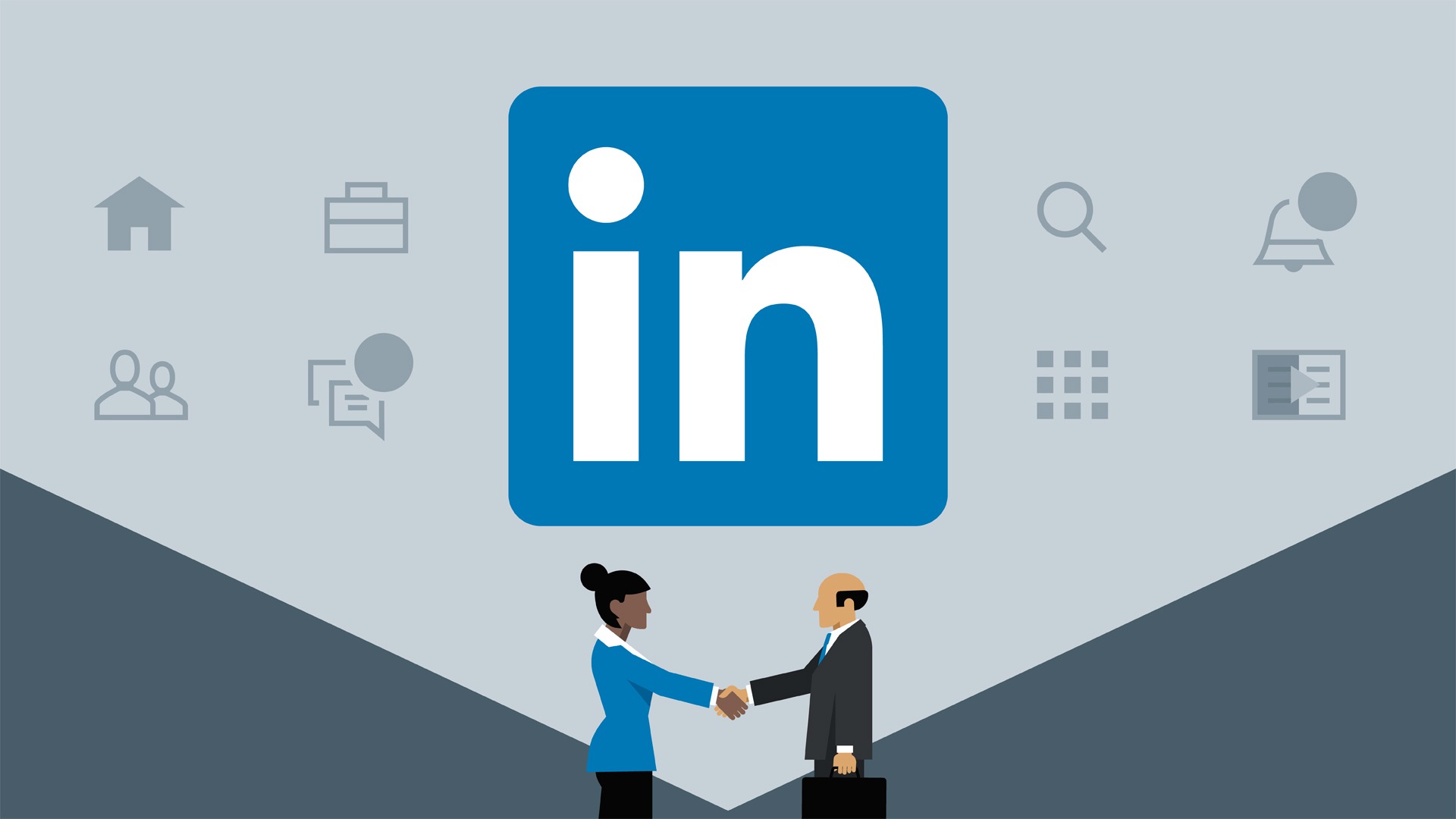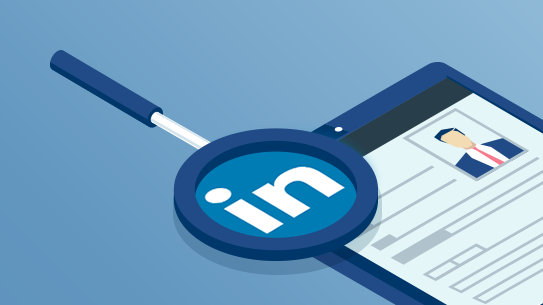
If you're on LinkedIn, it's not enough for your profile to simply just sit there. If you want to make your personal brand stand out against the large volume of users on the professional network, you need to fully optimise your profile. In this mega guide you will learn how to optimise your LinkedIn profile properly and create the best personal brand on the platform.
The objective of this post is to delve into the hidden depths of LinkedIn so you can discover all the functions offered by the platform and, above all, so you can make the most of it to create a stellar professions profile that differentiates you from your competition.
What is LinkedIn?
Founded in 2002 and with more than 590 million registered users, LinkedIn is today the leading social network for businesses and users who want to create and consolidate their professional identity on the internet.
But LinkedIn is much more than a social community focused on the business world. LinkedIn allows you to connect with acquaintances, friends, coworkers as well as any other contact related (or not) to your professional environment. Therefore, the value of LinkedIn lies in the connections.
In addition, LinkedIn is a tremendously effective way to create your professional CV online, as it allow you to visually display your skills, your 'know-how', your experience, your achievement, and other important information that we will detail later.
Before we get into the most practical part of this content, let's look at some data about this social platform...
Interesting Facts and Statistics about LinkedIn
LinkedIn in Figures
- Total number of users: 590+ million
- Total number of active users: 260 million
- % of active users daily: 40%
- Number of new users per second: 2
Demographic Data
- 70% of LinkedIn users are outside the US
- 61 million LinkedIn users have a senior professional level
- 40 million users are decision-makers
- 40 million users are students or have recently graduated
- 56% of users are men and 44% are women
- 13% of LinkedIn users are millennials
LinkedIn and Marketing
- LinkedIn is the first channel of content distribution for B2B companies
- LinkedIn accounts for more than 50% of social traffic for website and blogs of B2B companies
- 92% of B2B companies in the marketing sector include LinkedIn within their digital marketing strategy
- 80% of B2B company leads come from LinkedIn versus 13% from Twitter and 7% from Facebook
What is LinkedIn for?
LinkedIn is a social network that we all probably now know, although it hasn't quite reached the popularity of other social networks such as Facebook or Instagram.
However, those who are looking to use social networking platforms for ways to increase business opportunities have likely struggled to gain much success on Facebook or Instagram. In fact, people often reject commercial talk on either of these websites.
On LinkedIn, it's different. Being the professional social network of choice, the users are already commercially minded and open to business opportunities. For this reason, many business owners are turning to the platform to get more clients/customers and expand their business.
But, be careful not to use LinkedIn simply to find a new job. Keep in mind that a job, by itself, is something transitory. On the contrary, your personal brand is forever and that is what you should really be focusing on when it comes to LinkedIn.
LinkedIn Opportunities for Users and Businesses
There is another reason why you should consider being on LinkedIn...
Since the beginning of 2018 the platform has seen an incredible number of new users, especially in Spain and Latin America. This has given rise to a fantastic new opportunity to get your name out there across the world.
It's impossible to say, for sure, what the next few years will hold, but everything indicates that this trend will continue, so it is time to prepare yourself to stand out. Keep in mind that, as the number of users grows, your competition grows. Therefore, if you are going to Use LinkedIn, you have to excel.
Whether you are looking for job opportunities, interested in attracting new clients or investors, want to expand your network of contacts, or simply want to strengthen your personal brand, LinkedIn has many opportunities to offer.
Advantages of using LinkedIn personally
- It allows you to expand your network of contacts
- It allows you to create and consolidate your professional identity
- You can increase the recognition of your personal brand
- It gives you access to lots of job opportunities
- You can showcase your professional and education career, your achievements, and recommendations
- You can contact companies quickly and efficiently
- You can network using groups
- You can inform yourself with relevant news from your work sector
Advantages of using LinkedIn as a Business
- You can create a company page
- You can quickly inform people about job openings
- It is an open door to new business opportunities
- It allows you to capture leads
- You can increase your portfolio of customers, suppliers, or collaborators
- It allows you to increase the recognition of your brand
- You can give visibility to your employees
- You can position yourself as a thought leader in your sector by disseminating valuable content
As you can see, I have differentiated the benefits for companies and for personal profiles, and that there are distinct opportunities for both!
Of course, having a personal profile is necessary if you want to create and manage your own company's page on LinkedIn, so the first step is ensuring your personal profile is optimised properly before looking at the business profile.
However, before all of that, we need to begin by talking about keywords and SEO because yes, we can (and should) do SEO on LinkedIn and it is very important to keep it in mind when optimising your profile.
SEO on LinkedIn to Increase Visibility
Can we do SEO on LinkedIn? Not only can we do it, but we must work on SEO if we want our LinkedIn profiles to be fully optimised and stand out ahead of our competitors.
As we would do when writing content that we want to position on Google for, we must begin by asking two questions:
- How would my target audience look for me (potential clients, head hunters, potential collaborators... etc.)?
- What should my LinkedIn profile contain to ensure I am found by these people?
The answer to these two questions is in your keywords.
After all, LinkedIn is nothing more than a very powerful search engine for people and SEO on this platform is what makes it possible for someone to find us when they search for profiles similar to ours or related terms.
If you are interested in SEO more generally, I'd encourage you to read our Mega Guide to doing an SEO Audit in 2020.
How to Use LinkedIn to be More Visible?
To make ourselves visible in these search results, we have to ensure our profiles are optimised for those keywords we want to be visible for when someone types them into the search bar. So, how is this done?
1.) Define your keywords
At this point, rather than focusing on what defines you as a professional, focus primarily on what your target audience would look for.
When defining your keywords make sure you include those that represent:
- Your profession or what you do: "Digital Marketing Consultant"
- Your area of expertise: "Social Networks Specialist"
In any case, you have tools to find very useful keywords, such as Semrush, that can help you discover the exact things your audience is looking for and then use those keywords in your profile.
2.) Distribute those keywords throughout your profile
Once your keywords have been selected, ensure that they are evenly spread throughout your profile. It's most important to include the keywords in headlines, your professional experience, articles, and recommendations...
I recommend that you use your keywords in a natural way and not simply 'shoehorn' them in. Do it in such a way that whoever reads your profile can clearly identify what you do.
Also, remember that hashtags on LinkedIn are super effective, so make use of them.
How to create the perfect professional profile on LinkedIn
We have seen how more and more users come to LinkedIn in search of new opportunities both to boost sales and grow their business and to take their personal brand to new heights.
Therefore, and taking into account the data above, having a properly optimised profile is essential if we want to avoid being just another regular user on the platforms.
Business Card
The first step to optimise your LinkedIn profile is to complete the basic information located on the business card. This information is located at the top of the profile and it is the first thing that those who land on it will see. Here you can write what you do and, more specifically, how you can help.
Within it we find a series of sections that you can edit and customise using the button to the right of the box. Let's see what information you should include in each section and what the best way of doing it is:
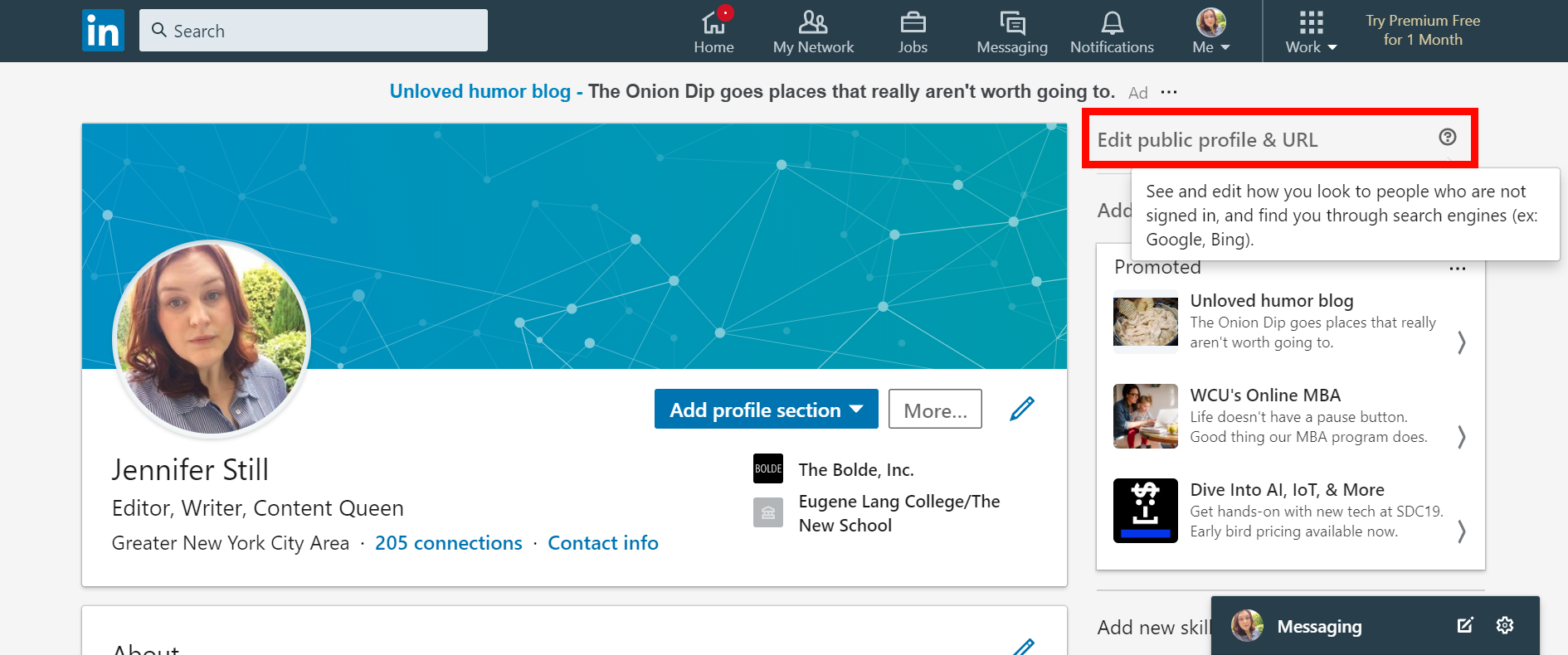
Profile and Cover Photo
A picture is worth a thousand words and, in this case, the saying is true. Whoever lands on your profile for the first time, the first thing that will capture their attention will be your cover and profile pictures, so make sure they show exactly what you want them to convey.
For the profile picture (400 x 400px), be sure to choose a professional photo that is high quality. You can ask yourself what you want to convey and try to capture that its your photo. On the right side of your profile, in the "Edit URL and public profile" section you can configure the privacy and visibility settings of your profile to decide if you want your profile picture to be visible only for contacts or for everyone. Personally, I would advise making your LinkedIn profile as public as you are comfortable with.
For the cover photo (1584 x 396px), use a quality image and try to include elements such as your logo, your brand name, icons of the social channels you use, and an eye-catching background
Name and Headline
It's vitally important that this section is optimised correctly. The information you include here will be what Google indexes to appear in search results and also in those of internal LinkedIn search results.
Therefore, you must be using your keywords here! But beware:
- When filling in your name, I advise you to ONLY write your name and nothing else. Avoid writing your position or work sector, since these have specific sections where they will be more effective e.g. the headline
- The headline, the line of text just below your name, will include your current job by default. The good thing is that LinkedIn allows you to customise this section and doing so can make a big difference.
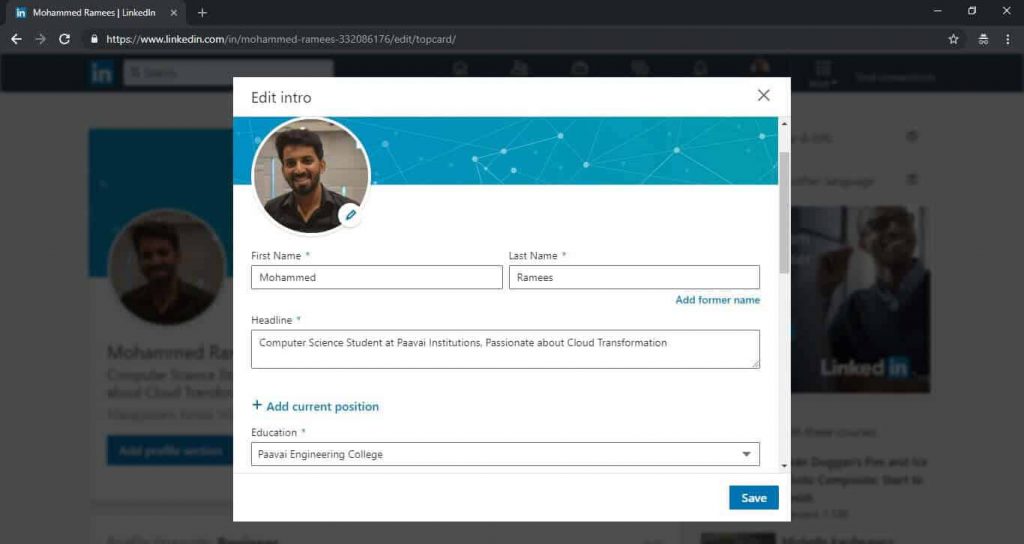
As with the cover of a book or the title of a post, the headline of your LinkedIn profile will be your great opportunity to capture the attention of users and attract their attention.
This is why your headline has to be written in such a way that it leaves an unbelievable first impressions and makes them want to know more about you. Here are some tips to help:
How to write a fantastic headline:
- Summarise very clearly, in one sentence, what you do and what benefit you bring to your target audience
- Use your keywords (how do you want to be found and what you want to be associated with)
- Include your work sector and niche
- If you have your own company, include that so they know who you work for
- If you have a particular slogan that can identify you or your company, then use that too
Location
Where are you currently based? By displaying this information on LinkedIn you are allowing users who see your profile to locate you at a quick glance and, in addition, it will help people find you if they are searching by location.
Sector
Filling in your specific work sector is another fundamental aspect if you want to be visible to those people who searched based on work sector.
Select the sector that best suits yours and, if you cannot find a suitable work sector that matches yours, you can make a suggestions to include it through the 'send comments' section at the bottom of the home page.
Work and Educational Information
This element shows, by default, the last position you help and your most recent place of education. You can customise this information and modify it to show exactly what you want to be displayed.
Contact Information
By completing the contact information, you help people to connect with you more easily. Such information that you should include here is:
- The URL of your website (personal, professional, or other)
- Other URLs that are associated to you
- Your social media profiles
- Your phone number and address
- Your e-mail address
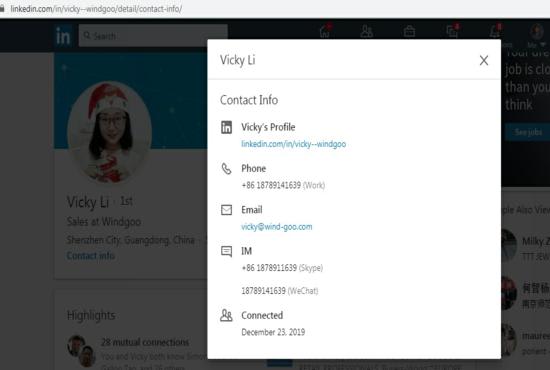
Number of Contacts
The number of contacts you have also appears on your profile and allows others to see the scope of your network.
The connections you make are very important, but the importance is quality not quantity. I advise you to find relevant and meaningful connections to create a qualified community on LinkedIn. Search for new connections every week and nurture those relationships for long term gains.
About
The about extract is the section where you can show a summary of your professional experience, your skills and other information in more depth compared to the headline. Think about how you would introduce yourself to a potential client and then fill in the about extract accordingly.
Tips to optimising the about section:
- Be authentic and show passion for what you do
- Try to put the most important information in the first three lines
- Talk about your skills and experience, but don't forget to show how you could be useful to whoever reads it
- Divide the about section in paragraphs of maximum three lines, to make it easier to read
- Add a call to action, inviting users to contact you, visit your website, share their experiences, etc.
- Use a friendly tone and sense of humour where possible
URL and Public Profile
On the right side of your profile, next to your cover photo, you will see a small section called "Edit public profile and URL"

When you access this section, you will see a different version of your profile where you can configure various aspects, such as the URL of your profile, the difference sections, and your profile visibility.
Your default URL, for your profile, isn't optimised for SEO, so you can customise it to remove any numbers or symbols that appear. Use a clear URL that contains your name and is easily identifiable to you.
When configuring LinkedIn visibility, you have the option the choose which sections of your profile you want to be displayed and to whom.
If, in addition to being shown to LinkedIn users, you want your profile to appear in Google search results and other search engines, you can activate that option here too.
Your Dashboard
Just below your business card you will see a grey box called 'Your Dashboard'. The information that appears on it is visible only to you and it is very valuable.
Firstly, it shows your level of effectiveness. There are 6 distinct levels that your profile can reach:
- Beginner
- Intermediate
- Advanced
- Expert
- All Star
Depending on how well you have optimised your page, you will receive a rating that will be visible here on your dashboard. Aim for All Star! If you aren't there yet, you will see a meter with a series of steps/tips to help you get there
Secondly, it shows your profile views. The corresponding data shows how many people visited your profile in the last 90 days accompanied with a graph.
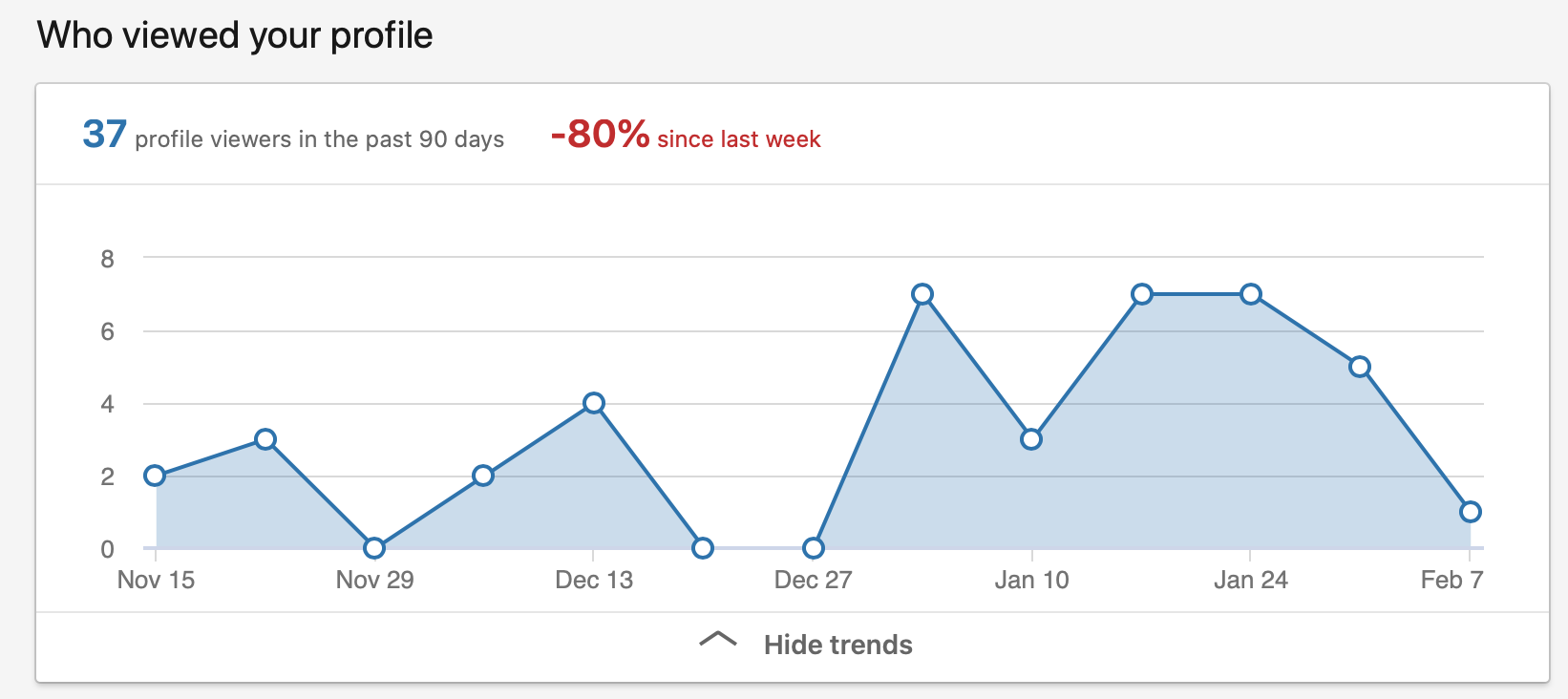
If you have a free profile, you will only have access to part of this information. To know more details you will have to update your account to Premium.
Article Views
This section also reveals the number of times all your articles were viewed, and if you click on the number you will see a breakdown of the stats for each article:
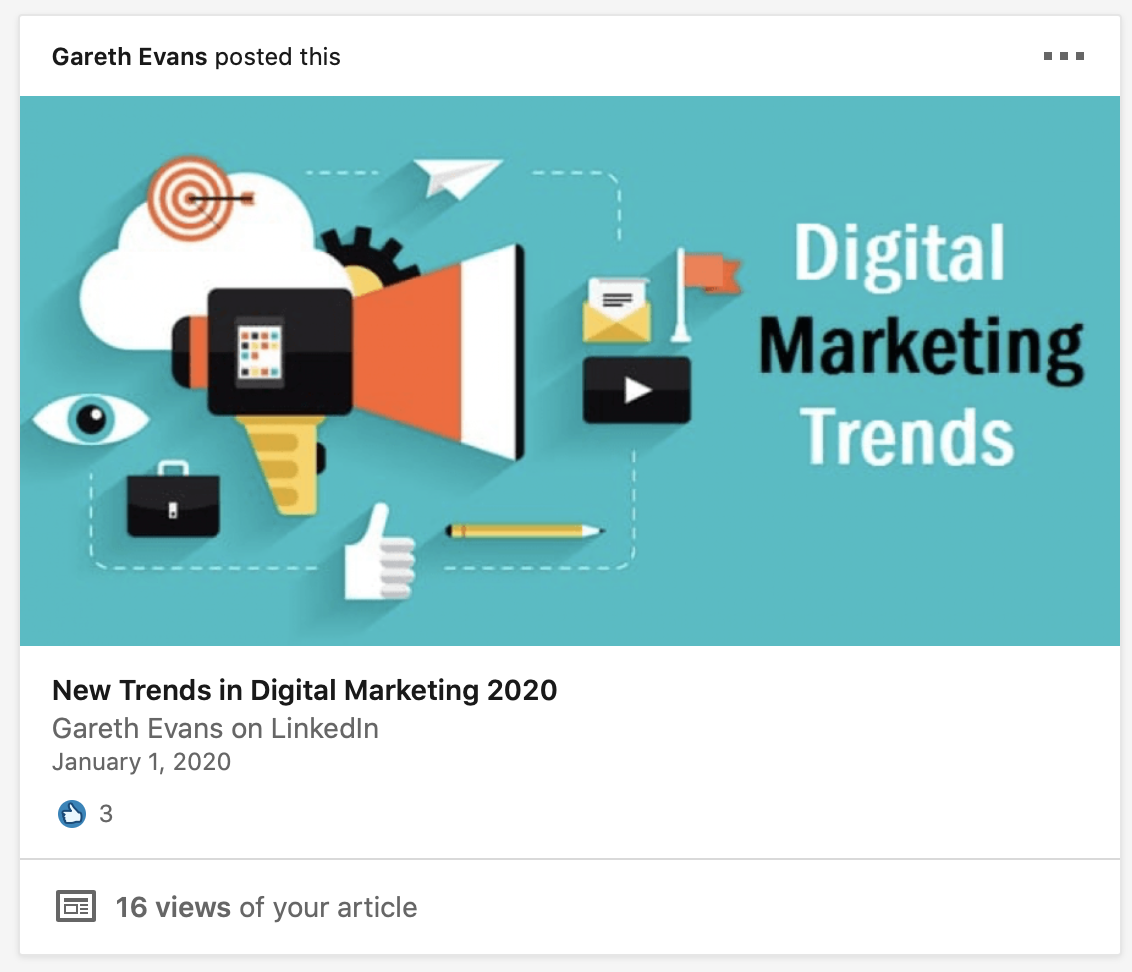
Search Appearances
Search appearances are the times your profile appears in search results. But there is more... If you click into this section, you will obtain some very interesting dats, such as:
- Your weekly statistics
- Where the people who search for you work
- What industry those people are in
- The keywords you appear for
Not only is this data interesting, but it reveals clues about how optimised for SEO your LinkedIn profile actually is.
Articles and Activity
In this section you will find how many people follow you, plus two other types of content that define how active you are within LinkedIn.
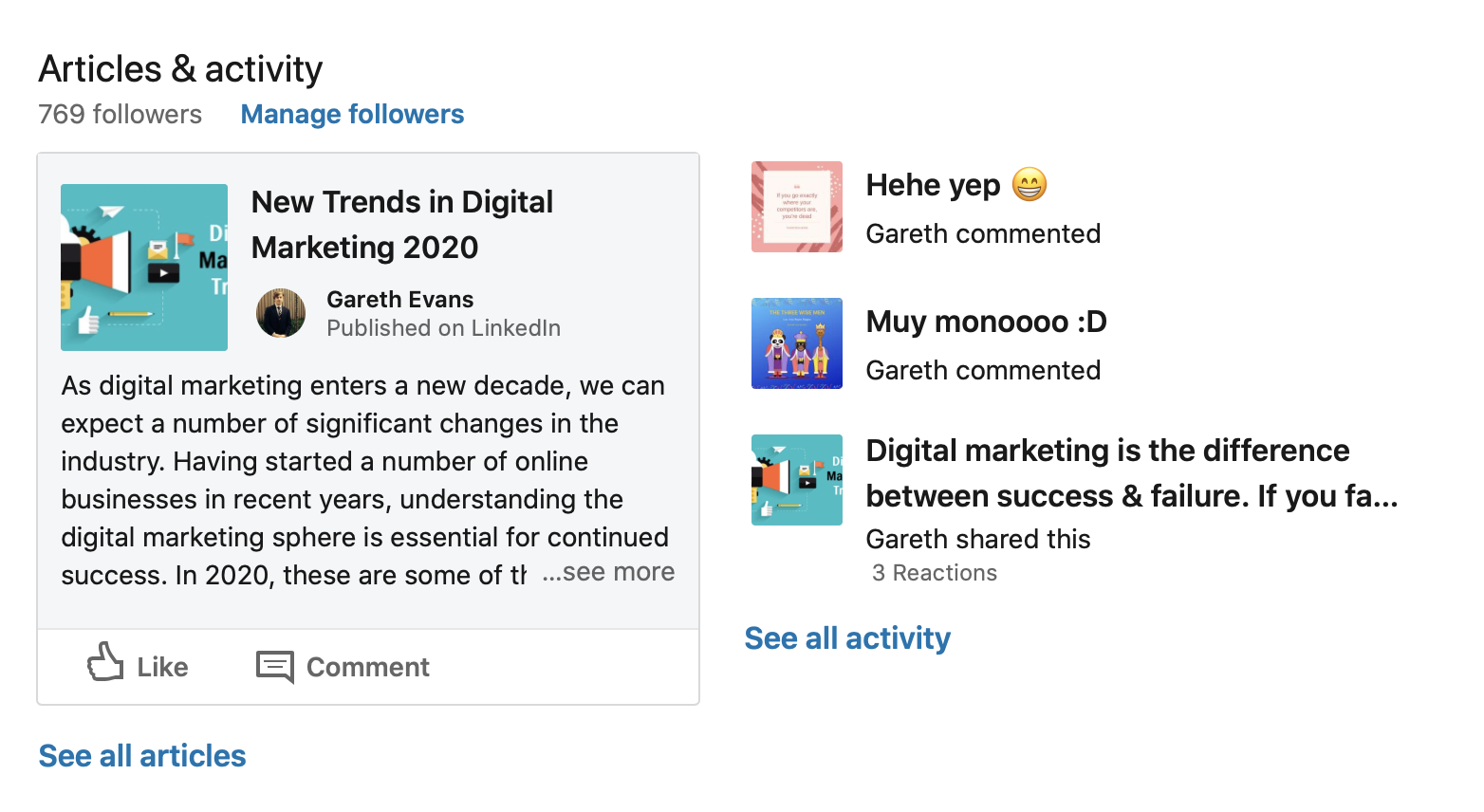
Articles
These are the publications made using LinkedIn's blogging tool. The blogging/article tool allows you to integrate a content marketing strategy without leaving the social network, as well as highlight your professional skills, increase your credibility, and strengthen your brand.
In addition, articles published through LinkedIn are indexed by Google and the main search engines. Therefore, when writing articles on LinkedIn remember to optimise them with keywords both in the title and main body.
To write an article:
- Go to your Home page
- Scroll to the top and find the post creation box at the top of the feed
- Click 'Write an article'
- Write your article on the new page

Activity and Interaction
This section shows your activity within the LinkedIn feed. Here you will see a preview of your latest posts and your latest interactions both on your posts and other people's posts (recommendations, comments, etc.)
To improve and strengthen your LinkedIn profile, it is advisable to maintain a balance between these types of activity: write articles, share publications, and interact
Sections
The remaining part of the page is split up into individual sections, that make your profile unique.
To quickly add a new section you should see a blue button appear in the top right of the page, which reads 'Add section'

In that window, you will see 7 sections with different elements in each of them that you can add by pressing the '+' symbol, depending on what you are interested in showing on your profile.
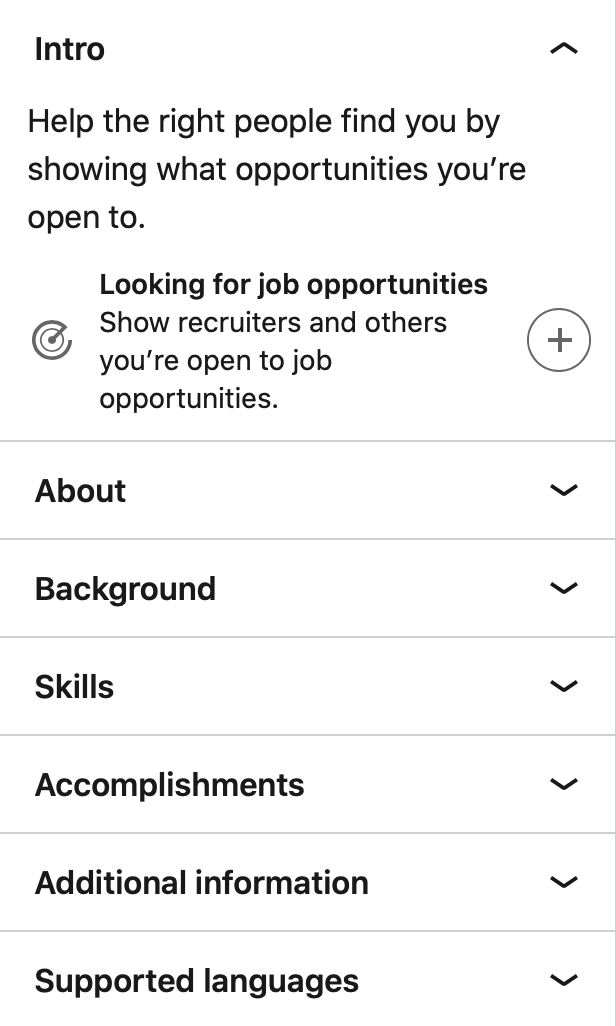
Experience
Use this section to add all the job roles you have held, as well as any training and volunteer experience.
In doing this, it is essential that you include your keywords. If possible, include the keywords in the name of the position and in the job description. However, try to implement them naturally as if you were telling a story.

Another important aspect that you should keep in mind in this section is to use multimedia content. If you add 'extra' content such as images, presentations, links, videos, a portfolio, etc., you will not only have a more complete profile, but visually it will be much more attractive.
Skills
The skills represent your most important abilities. By adding them to your profile you can not only highlight them, you also allow your contacts to validate them by endorsing them.
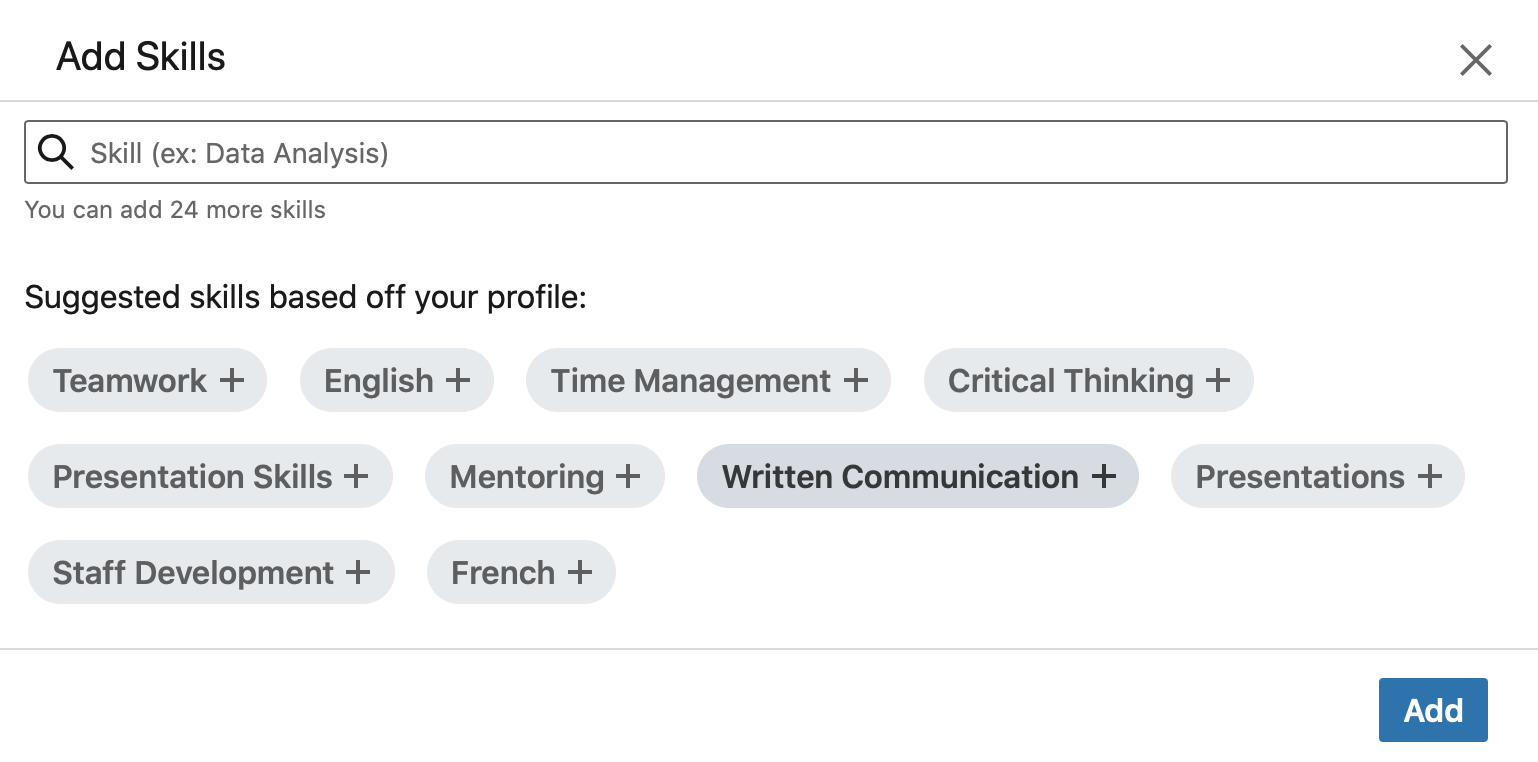
On the other hand, LinkedIn skills also fork as keywords and by using them you will be helping with SEO positioning within the social network, meaning it will be easier for people to find you when typing those keywords.
LinkedIn allows you to add 50 skills and you can highlight 3 of them, so choose wisely!
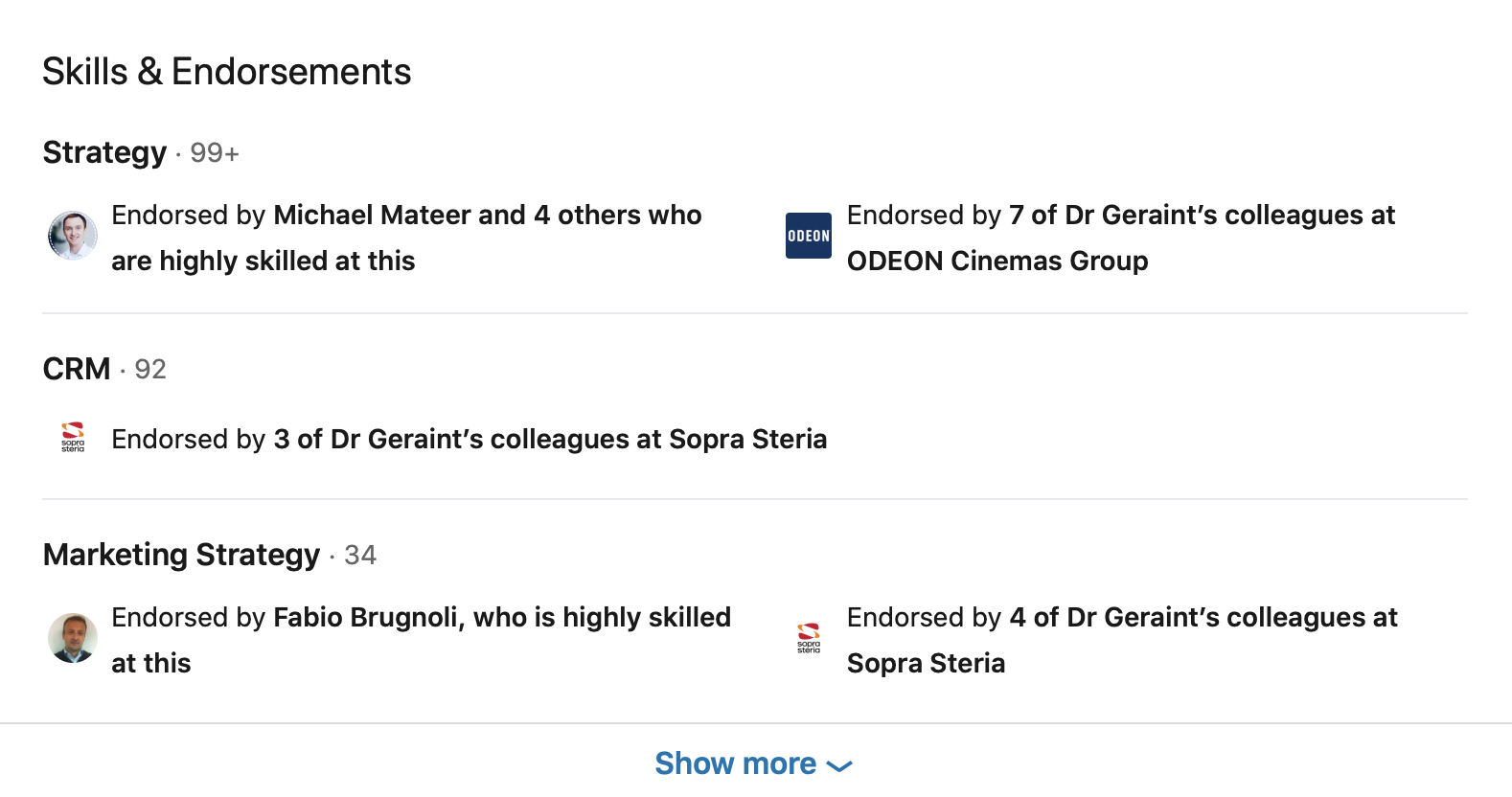
Accomplishments
In the accomplishments section, it is split up into several distinct types of accomplishment:
- Publications
- Patents
- Courses
- Projects
- Honours and Rewards
- Test Scores
- Languages
- Organisations
Your achievements add value to your profile, so take advantage of them and spend time completing this section. The richer and more complete your profile, the more valued it will be
Recommendations
This is one of the most important elements of your profile. The recommendations present the perfect opportunity for other contacts to give reliable proof to your professional qualifications.
Having a good compilation of recommendations will give your profile a lot of value and strength. In addition, if your keywords are found in them, this will favour SEO positioning.
Supported Languages
The last section of the blue 'Add profile section' button allows you to create versions of your LinkedIn profile in multiple languages.
If you want to gain worldwide exposure, creating a version of your page in different languages is a great idea. Having a profile in different languages will allow other users and recruiters to find you more easily.
Now that you have analysed each section of your profile, one by one, and I have given you guidelines on how to complete and optimise each one, go and check the score LinkedIn gives you now!
What is the SSI on LinkedIn and why should you measure it?
The LinkedIn SSI refers to Social Selling Index and it is a formula that measures the effectiveness of your social selling practices on the platform.
But, beware, we should not associate the indicator solely with how well we sell a product or service. With the Social Selling Index we can measure the progress we are having with developing our personal brand i.e. how well we sell ourselves.
The SSI, introduced in 2014, gives your profile a score between 1 and 100, and it is based on a number of criteria. These criteria determine if you are selling yourself well or poorly.
Want to know your SSI? Find your SSI here.
What is it based on and how can you improve your LinkedIn SSI?
The SSI is updated daily and it is based on 4 fundamental pillars:
- If you have a complete and updated profile and share valuable, relevant and compelling content
- If you find and connect with relevant people through the search tool offered by LinkedIn
- If you interact and generate conversations with interesting content
- If you establish relationships and strengthen connections with your contacts
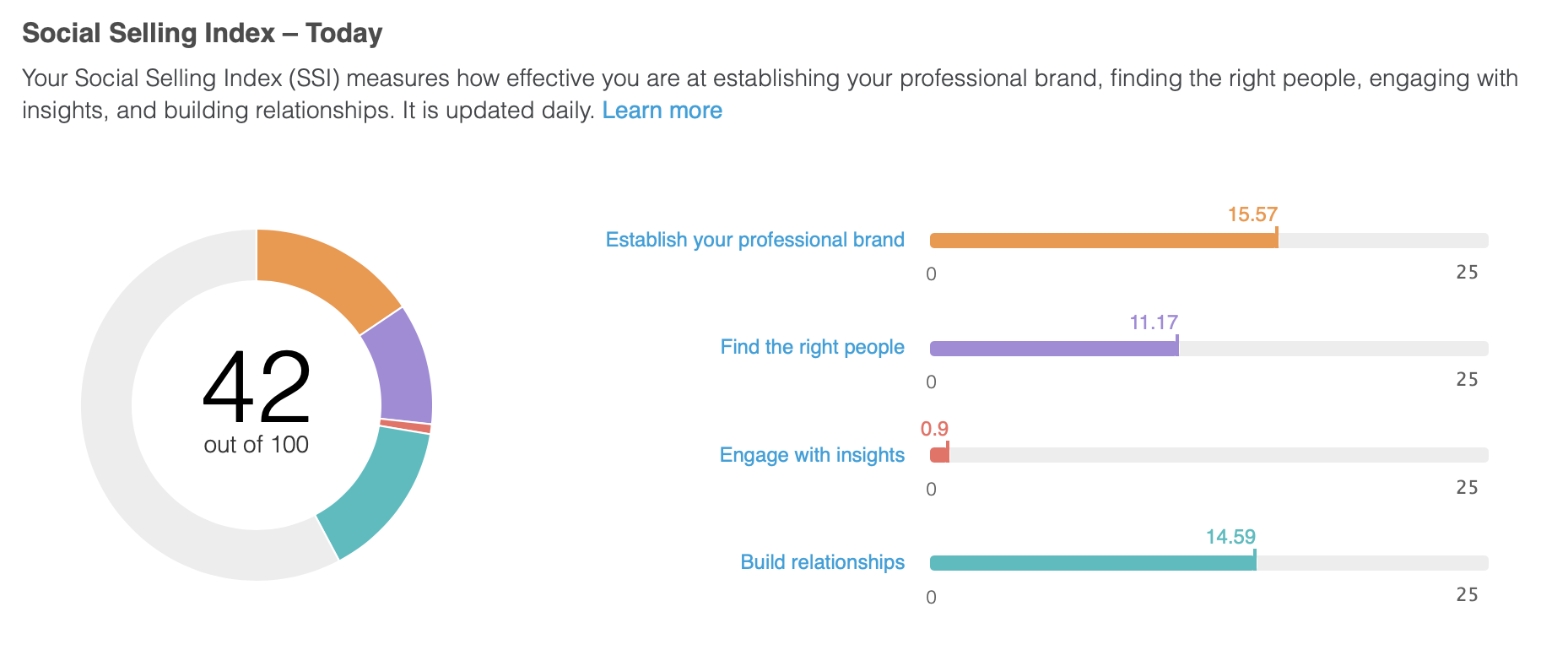
How to improve your LinkedIn SSI in 6 steps
- Keep your profile updated and make sure it is complete
- Increase and reinforce your presence on LinkedIn by publishing more frequently (minimum 3 times per week)
- Do not share any content, make sure it is content focused on the interests of your target audience, and that it is relevant to your work sector
- Search for new connections daily using LinkedIn's advanced search tools (#)
- Participate in groups related to your work sector
- Interact! The real value of LinkedIn lies in the connections.
15 Extra Tips for your LinkedIn Strategy
After completing the audit and optimising your profile, take account of these additional tips that you can apply to your profile and overall strategy:
- Be consistent and keep your account active. Post at least 3 times a week
- Interact on your own publications and those of the community
- Keep your profile updated and optimised with your keyword selection
- Collect multimedia content to include on your profile
- Check the statistics of your occurrences in search weekly and optimise you auctions based on the results
- Search for new users to connect with that fit your target audience through the powerful internal search engine
- Customise your invites by writing a personalised message
- Get recommendations from former classmates, work colleagues, friends, and ask them to include some of your keywords
- Don't just share third party content. Generate your own content, making sure it is relevant
- Use hashtags in your post (2-3 max). They will help make you more visible across the platform
- Include video in your content strategy. As video isn't that common across the platform, it will attract more attention and generate greater engagement
- Find relevant posts through keyword searches with the content search engine, and interact with them to make you more visible regarding those topics
- Use LinkedIn groups. Participate in them by sharing your content and interacting with other content relevant to your area of expertise.
- You could include audio notes in your private message. Use them to generate greater trust and approachability
- Include the URL of your profile in your email signature, your other social channels and business cards to attract more visitors to your page
Now you just have to go out there and apply all the recommendations in this guide!
If you like this content you’re going to love everything else I do. I want to provide you with unbelievable value so you, too, can achieve all your business goals. Let me know what you think of this post and I'd be happy to help any of you guys who may be struggling with your own efforts to rank on the first page of Google. Also check me out on Instagram, YouTube, and Facebook. 😁
Thanks,
Gareth
